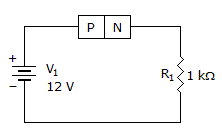Discussion
Home ‣ Electronics ‣ Semiconductor Principles Comments
- Question
In "p" type material, minority carriers would be:
Options- A. holes
- B. dopants
- C. slower
- D. electrons
- Correct Answer
- electrons
ExplanationThe purpose of p-type doping is to create an abundance of holes. In the case of silicon, a trivalent atom (typically from Group 13 of the periodic table, such as boron or aluminium) is substituted into the crystal lattice. The result is that one electron is missing from one of the four covalent bonds normal for the silicon lattice. Thus the dopant atom can accept an electron from a neighboring atom's covalent bond to complete the fourth bond. This is why such dopants are called acceptors. The dopant atom accepts an electron, causing the loss of half of one bond from the neighboring atom and resulting in the formation of a "hole". Each hole is associated with a nearby negatively charged dopant ion, and the semiconductor remains electrically neutral as a whole. However, once each hole has wandered away into the lattice, one proton in the atom at the hole's location will be "exposed" and no longer cancelled by an electron. This atom will have 3 electrons and 1 hole surrounding a particular nucleus with 4 protons. For this reason a hole behaves as a positive charge. When a sufficiently large number of acceptor atoms are added, the holes greatly outnumber thermal excited electrons. Thus, holes are the majority carriers, while electrons become minority carriers in p-type materials. - 1. Which semiconductor material is made from coal ash?
Options- A. germanium
- B. silicon
- C. tin
- D. carbon Discuss
- 2. Which of the following cannot actually move?
Options- A. majority carriers
- B. ions
- C. holes
- D. free electrons Discuss
- 3. One problem with mechanically variable resistors is noticeable in audio circuits as:
Options- A. scratchy noise
- B. lack of bass response
- C. variable volume
- D. too much treble response Discuss
- 4. With Ohm's law, no change in resistance means that current and voltage will be:
Options- A. directly proportional
- B. unable to produce energy
- C. the same
- D. inversely proportional Discuss
- 5. A wire with a smaller cross-sectional area will produce:
Options- A. less heat
- B. more conductance
- C. less resistance
- D. more heat Discuss
- 6. When an electron jumps from the valence shell to the conduction band, it leaves a gap. What is this gap called?
Options- A. energy gap
- B. hole
- C. electron-hole pair
- D. recombination Discuss
- 7. Ionization within a P-N junction causes a layer on each side of the barrier called the:
Options- A. junction
- B. depletion region
- C. barrier voltage
- D. forward voltage Discuss
- 8. Silicon atoms combine into an orderly pattern called a:
Options- A. covalent bond
- B. crystal
- C. semiconductor
- D. valence orbit Discuss
- 9. Which material may also be considered a semiconductor element?
Options- A. carbon
- B. ceramic
- C. mica
- D. argon Discuss
- 10. What is the voltage across R1 if the P-N junction is made of silicon?

Options- A. 12 V
- B. 11.7 V
- C. 11.3 V
- D. 0 V Discuss
Semiconductor Principles problems
Search Results
Correct Answer: germanium
Correct Answer: ions
Correct Answer: scratchy noise
Correct Answer: directly proportional
Correct Answer: more heat
Correct Answer: hole
Correct Answer: depletion region
Correct Answer: crystal
Correct Answer: carbon
Correct Answer: 11.3 V
Comments
There are no comments.More in Electronics:
Programming
Copyright ©CuriousTab. All rights reserved.
